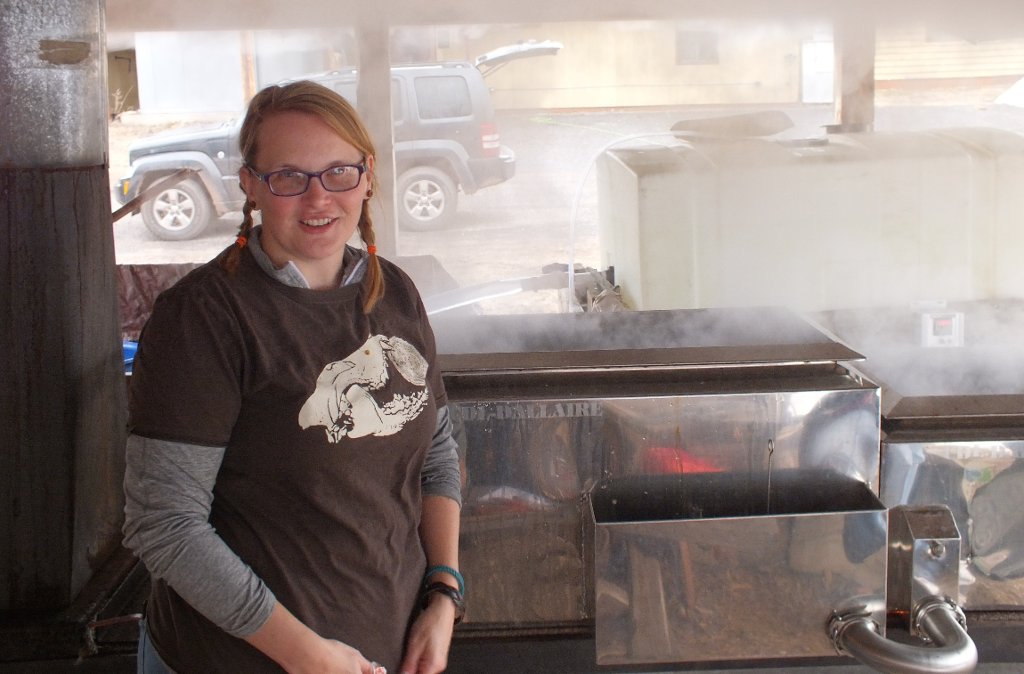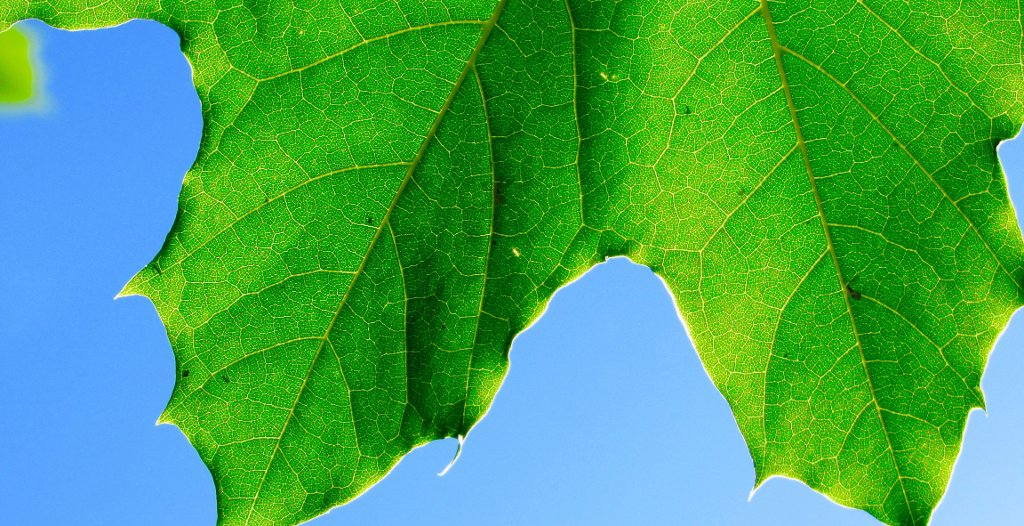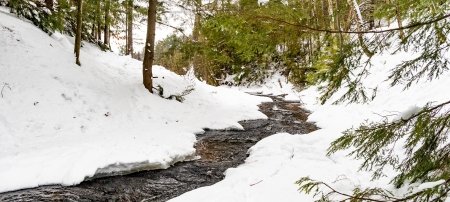Plonk. Plonk. Plonk. The sap drips hitting the bottom of galvanized buckets in Preacher Park are louder than the raindrops on an April weekend at Michigan Tech's Ford Forestry Center.
The buckets aren't full yet. But across US-41, Tara Bal's maple syrup management and culture class is collecting from the sugarbush maples that line the streets of Alberta Village. The trees look a little like hospital patients receiving IV drips. Some bear rectangular blue sacks; you can see the clear liquid inside. Flexible, thin blue tubing protrudes from the tap holes on others, snaking down into white plastic buckets.
But tapping doesn't hurt the trees, says Bal, a research assistant professor in the School of Forest Resources and Environmental Science(SFRES)—you can pinpoint her location by following the smoke billowing above the Sugar Shack, out back of the research, education and conference center's dining hall and dorms. This year's sugarbush sap boil is in full production mode.
A lot had to happen beforehand. Selected entries from this year's Sugarbush journal:
February 2-22—Firewood, move evaporator, tanks, bucket to shack. Buy drill bit and mallet. Everything still needs cleaning.
February 23—Tap five birch on campus.
February 27—Tapped five trees at Forest Center.
March 2—Check sap bags. Too cold to tap trees.
March 3—Tap trees, check sap.
March 6—Got more buckets, tapped as many trees as we had buckets, bags, taps.
March 19—Pray for better weather, take more pictures
March 23—Check buckets, bags, got about 1/2 bucket of sap, pray for better weather.
March 25—Collected sap, about eight buckets
March 26—Collected sap, eight half-buckets.
March 27—Collected sap.
March 28—Mini boil, get pump-and-draw system operational. Gathered 13 buckets of sap, evaporated about 50 gallons.
April 1—Boil sap
April 2—Boil sap
April 3—Boil sap
April 5—Finish boiling, make candy, bottle syrup
April 7—Clean kitchen.
Total taps: 73
Total gallons: About 500
Ford Forestry Center, the planned community of Alberta built by Henry Ford, is graced with fine maple specimens. How long has syrup been made here? "As long as Ford was here, and before that, the Anishinabe," says Bal.
"A complete syrup and sugar maker comprises in himself a woodcutter, a forester, a botanist, an ecologist, a meteorologist, an agronomist, a chemist, a cook, an economist, and a merchant. Sugaring is an art, an education, and a maintenance."
A couple of different boils are underway, using the wood-fired evaporator and the traditional Native American method: bringing the sap to boil with fire-heated rocks in a hollowed-out maple log.

Bringing the sap to the desired 219 degrees F, optimal boiling temperature, is easier in the wood-fired evaporator. The equipment was previously used for popular syrup-making events organized for private landowners and local school students, Forest Environmental Resource Management (FERM) projects that drew up to 500 people. Those workshops, which ended in 2013, began with boiling pans and basically a super-sized home setup, but eventually netted enough in syrup sales to purchase more and better equipment over the years, including a CDL 20-by-66-inch evaporator.
Bal, whose PhD work centers on sugar maples, and who remembers syrup-making from growing up in a tightknit Amish community, didn't like to see it sitting there unused. She wrote a development grant for a non-traditional online course, which includes a fieldwork component and has the added benefit of introducing students to forestry and biology, including how tree physiology relates to sap flow.
The maple syrup production and culture course, covering all phases of the process from traditional culture to marketing and business practices, has been going on for three years. Most of the 40 students in this year's class hail from other departments and schools across campus, says Bal. The class acquaints them with SFRES and what it has to offer: which at the moment is sausage and pancakes doused in darker-than-usual but still tasty maple syrup. When Bal went to the kitchen to see how further heating, combined with filtering and skimming, was going, somebody let the evaporator temperature drop, and that's how the darker color ensued. Bal calls it "campfire syrup."
Luckily, it didn't ruin the taste, and the syrup makers were vigilant during succeeding batches.
All a part of the learning curve. And another item on the Sugarbush checklist for next year: Make sure people check the evaporator consistently/assign roles on big boil days.
Syrup Comes from Many Species
Syrup is usually made from seven to 10 different maple species common to the US, Bal says. But you can tap other trees, for example, yellow or paper birch. Sugar content and taste vary by species.
Bal tapped birch trees on campus and made birch water. With a lower sugar content, it tastes like water, with a bit of a nutty aftertaste.
"Tapped trees remain healthy, as long as you're being responsible and not putting too many taps in a tree," says Bal. Field techniques teaching assistant Kaydi Picard explains that trees form a scar, with a vertical zonation line. New layers of wood grow over it. And in some markets, the kind of grain that produces is actually coveted. "People pay high prices for tapped maple lumber," says Bal.
Take That, Broccoli
Forty gallons of maple sap makes one gallon of syrup—and less than a gallon of sugar. Speaking of which, maple syrup is a healthy alternative to cane sugar, has two-thirds the calories of corn syrup, reduces risk of heart disease, and is full of antioxidants. Four tablespoons has the same antioxidant value as a serving of the vegetable President George H.W. Bush banned from Air Force One. At a time when farm-to-table and locally-sourced are buzzwords, syrup-making fits right in with the sustainable activities like keeping a garden, bees or chickens.
"It's a gift from your trees, a food resource year after year, and it doesn't kill anything."— Tara Bal
And its uses go far beyond pancakes. Bal says students have compiled more than 120 recipes. A few examples include your typical maple doughnuts, muffins, scones, coffee cakes, and cookies, but others are home-made maple baked beans, maple chipotle chicken tacos, maple bread pudding, maple whiskey, maple glazed salmon, and even the “ultimate brussel sprouts with bacon, beer, maple syrup, and mustard," says Bal. " I think we should have that one during boiling next year!"
Want Syrup?
Maple products, including leaf-shaped candy, sugar, and syrup ($12 for a large, $7 for medium, and $5 for small) is available weekdays in Noblet 128 in the SFRES complex off MacInnes Drive, while supplies last.

Feel like it's too high a price? All the proceeds go back to the class for purchasing consumables and equipment like new, clean taps and buckets for next year. Not your favorite color or have sugar crystals in the bottles? It’s made by students, but it still tastes great! Want to help promote maple sugaring at Michigan Tech, but there’s no more bottles left? Give a gift to the Maple Syrup Program Development to help deepen emphasis on cultural and historical importance of this little-known Michigan Tech tradition.
Michigan Technological University is an R1 public research university founded in 1885 in Houghton, and is home to nearly 7,500 students from more than 60 countries around the world. Consistently ranked among the best universities in the country for return on investment, Michigan's flagship technological university offers more than 120 undergraduate and graduate degree programs in science and technology, engineering, computing, forestry, business, health professions, humanities, mathematics, social sciences, and the arts. The rural campus is situated just miles from Lake Superior in Michigan's Upper Peninsula, offering year-round opportunities for outdoor adventure.






Comments